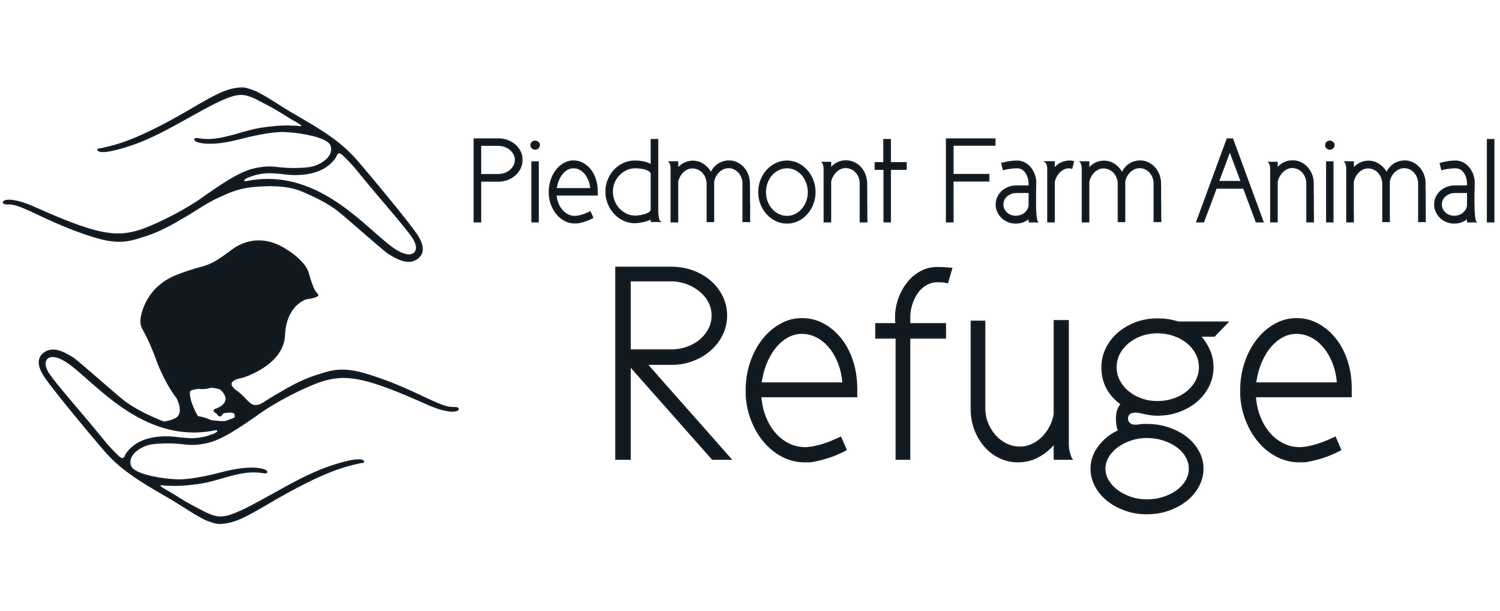Factory Farming: Goats
By Barbara Hengstenberg for Piedmont Farm Animal Refuge
Imagine living in a beautiful home designed and built just for you and your family and friends. Imagine never going hungry, with caring people taking care of your every need. Imagine having the run of the pasture and the woods, and a cool barn to retreat to when it’s too warm to sleep in the sun. If you’re a resident at the Refuge, this is your reality.
Sadly, it’s not like this for millions of other goat friends. While goat meat and milk is most popular in Latin American, the Caribbean, and in Muslim communities, approximately two million goats are raised for meat in the U.S. alone, and another half-million are raised for milk and mohair (who usually wind up being sold for meat). In the United States, goat meat consumption increased by 64 percent between 1999-2005, with expected growth of 10 percent per year. The top goat producing states are Texas, Tennessee and California, while the U.S. imports greater than 17 million pounds of goat meat from Australia and New Zealand due to rising demand. Many goats are killed in ritual, many times held by the back leg while their throat is cut. The rising demand for halal and kosher meat has increased the amount of urban live meat markets…live animals sold on the streets for slaughter.
Goats raised in factory farms are often kept on the range with inadequate protection from weather extremes and often in feedlots, where they are confined in filthy, crowded pens, which often leads to respiratory ailments. On factory farms and most small farms, the horn buds of kids (often just a few days old) are burned off using a searing iron. This is extreme torture to these baby goats, who screech in severe pain throughout this process which burns nerves and surrounding flesh. This practice leads to a great possibility of infection and brain damage. Dairy farmers disbud or dehorn goats so they will more easily fit into milking machinery. However, goat horns consist of bone and blood vessels. If they are allowed to grow and then are cut using a bone saw, severe bleeding can ensue. Goat horns are an important part of their bodies, as they help regulate bodily temperature, provide self-defense against predators, and help them to scratch.
On dairy farms, goats are kept constantly impregnated in order to continually produce milk for human consumption. Their babies are taken from them at birth so that their mothers’ milk will instead be used for humans to drink or make other dairy products such as cheeses and yogurts, or beauty products such as lotions and soaps. If you are born a male goat on a dairy farm, you will most likely be slaughtered immediately, as you are of no use in the dairy industry.
Sweet Mama goat (pictured above) was born on a dairy farm, where each year she gave birth to kids who were taken from her to be raised by humans. After seven years, when her milk production declined, she was brought to auction to be sold for slaughter. Remarkably, she escaped by jumping fences, and was cared for by a woman who found her living in a field, where she gave birth to two kids, Ace and Ivy. All three became residents at Piedmont Farm Animal Refuge, where they lived together until Sweet Mama died in the spring of 2019. Ace and Ivy continue to live peaceful lives, never having the worry of slaughter (which would have been Ace’s fate as a male on a dairy farm) or the abuse that would have happened to Ivy as a fertile female goat on a dairy farm. Sweet Mama chose to save her two babies, and she will always hold a special place in the hearts of everyone at the Refuge.
What can you do to help the goats who aren’t as lucky as Ace and Ivy, and continue to face the horrors of factory farming? A first step might be to visit the Refuge where you can see what life is like for our goat residents. After a life of trauma and abuse, or watching family and friends suffer, the goat residents at the Refuge now live in a place where every morning, their barn door opens to a friendly face who whispers “good morning” as they frolic out into the new day’s sun.
Consider and promote alternatives to the cruel practices of factory farming. Learn more about reducing your consumption of and use of goat products. Share what you’ve learned with others.
Resources:
Bauer, Gene. Farm Sanctuary: Changing Hearts and Minds About Animals and Food. NY: Simon & Schuster, 2008. pp. 144-146.
Hatkoff, Amy. The Inner World of Farm Animals: Their Amazing Social, Emotional, and Intellectual Capacities. NY: Henry N. Abrams, Inc. 2009. pp. 123, 142-144.


